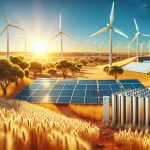In a groundbreaking move towards renewable energy, a new solar farm has been unveiled on a brownfield site in Rivesville, West Virginia. Spanning 27 acres of land previously designated for coal ash disposal, the solar farm now stands as a symbol of progress and sustainability in the region.
Unlike its coal-burning predecessors, this solar farm, spearheaded by Mon Power and Potomac Edison, marks a shift towards cleaner energy production. Constructed with locally sourced materials and utilizing US-made solar panels, the farm is now supplying clean electricity to nearly a thousand homes in the area.
Following the success of this project, the utilities are forging ahead with plans for further solar developments. The ongoing construction of the Marlowe solar farm in Berkeley County signals a commitment to expanding renewable energy sources across West Virginia.
This transition aligns with recent legislative changes aimed at boosting solar energy infrastructure in the state. By tapping into brownfield sites, West Virginia is diversifying its energy portfolio while also attracting new investments and fostering economic growth.
As the state gears up for more solar initiatives, the potential for job creation and environmental conservation looms large. Through initiatives like these, West Virginia is poised to shine bright on the renewable energy map, paving the way for a cleaner and more sustainable future.
Expanding Solar Power in West Virginia: The Next Steps Towards a Sustainable Future
In the wake of the successful launch of the solar farm in Rivesville, West Virginia’s renewable energy landscape is experiencing significant growth and transformation. While the initial project marked a crucial turning point, several key questions now emerge as the state moves forward with its solar expansion initiatives.
What are the Key Challenges Associated with Solar Expansion in West Virginia?
One of the primary challenges facing solar expansion in West Virginia is the need for comprehensive infrastructure development to support the integration of solar energy into the existing power grid. This includes upgrading transmission lines, implementing smart grid technologies, and optimizing energy storage solutions to ensure reliable electricity supply during periods of high demand or low sunlight.
Additionally, navigating regulatory frameworks and policies related to renewable energy deployment poses a significant hurdle. Streamlining permitting processes, addressing interconnection issues, and establishing clear guidelines for solar installation incentives are crucial steps to foster further growth in the solar sector.
What are the Advantages and Disadvantages of Solar Power Development in the State?
Advantages of expanding solar power in West Virginia include reduced greenhouse gas emissions, improved air quality, and job creation in the clean energy sector. By embracing solar energy, the state can enhance energy independence, drive innovation, and attract additional investments in sustainable infrastructure.
However, challenges such as intermittency of solar generation, land use conflicts, and initial capital costs for solar installations must be carefully managed to ensure the successful integration of solar power into West Virginia’s energy mix. Balancing the economic benefits of solar development with environmental considerations is essential for achieving a sustainable energy future.
What Lies Ahead for West Virginia’s Solar Industry?
With ongoing projects like the Marlowe solar farm in Berkeley County gaining momentum, West Virginia is on track to further expand its solar capacity and solidify its position as a leader in renewable energy adoption. The state’s commitment to leveraging brownfield sites for solar development underscores its dedication to environmental stewardship and economic diversification.
Moving forward, continued collaboration between utilities, policymakers, and renewable energy advocates will be crucial in overcoming challenges and driving the widespread adoption of solar power in West Virginia. By embracing innovation, fostering public-private partnerships, and prioritizing sustainability, the state can pave the way for a brighter, cleaner future powered by solar energy.
For more information on West Virginia’s renewable energy initiatives and the latest developments in the state’s solar industry, visit solar.energy.gov.







